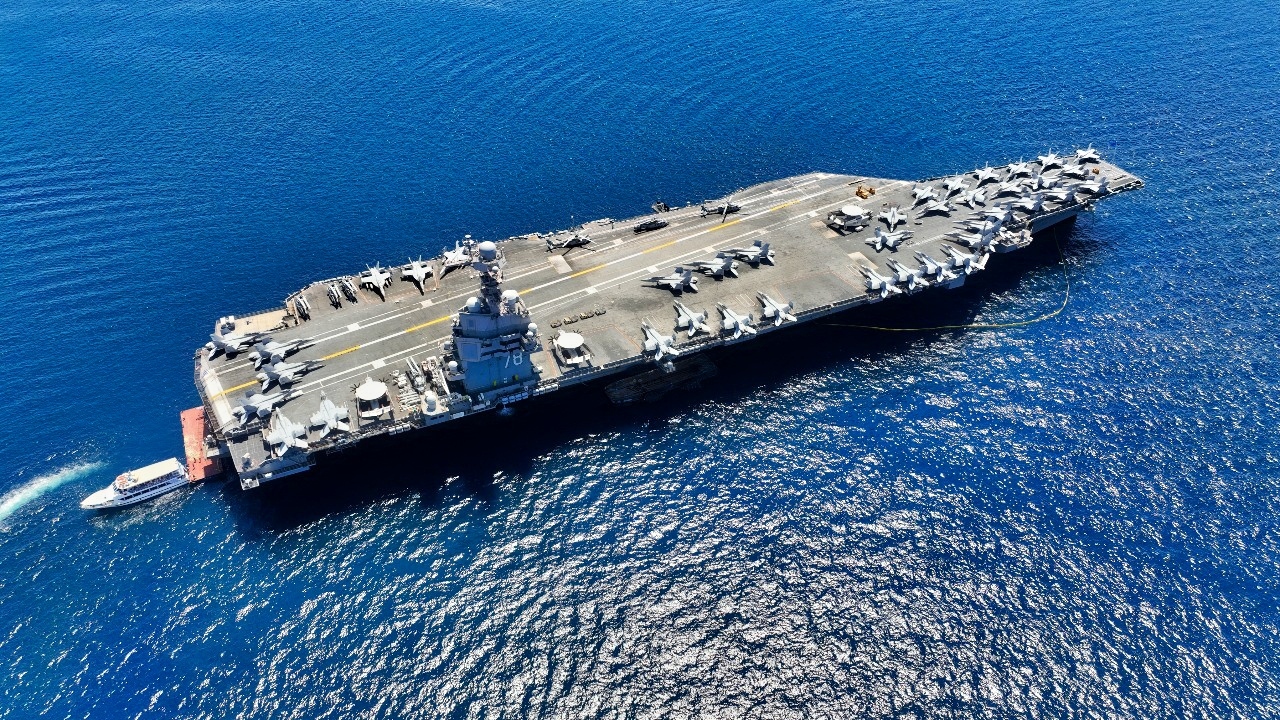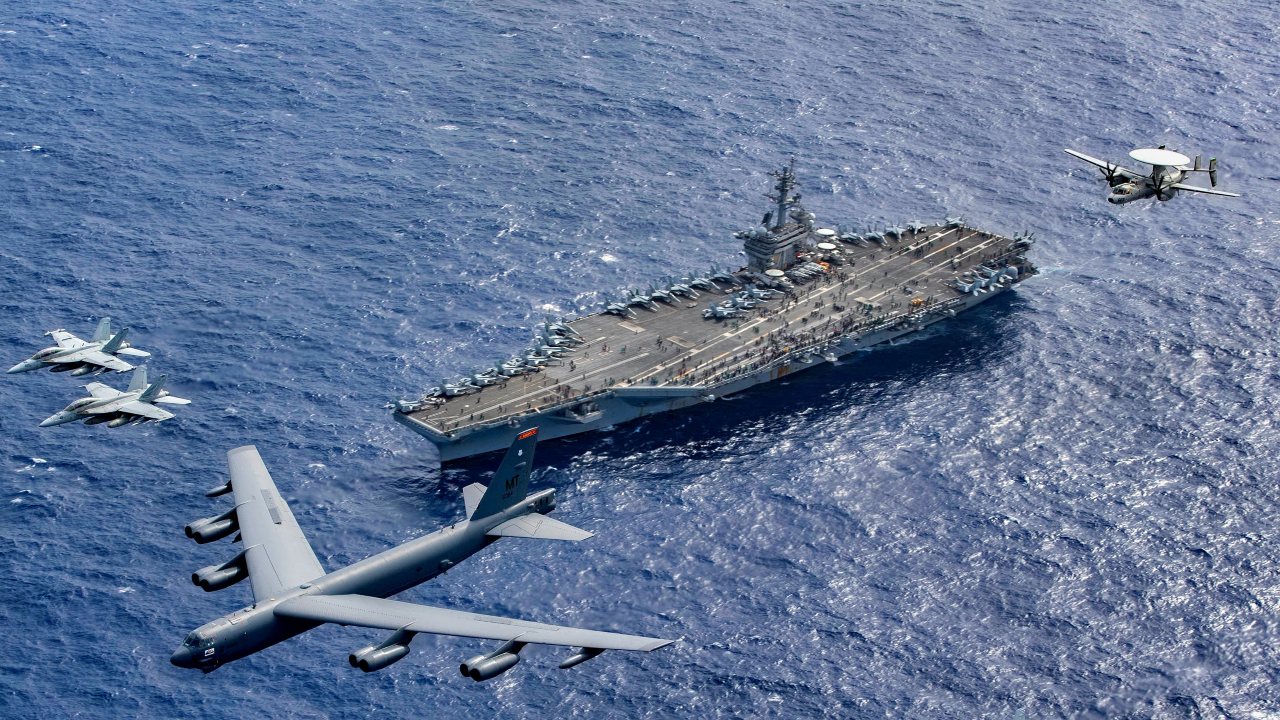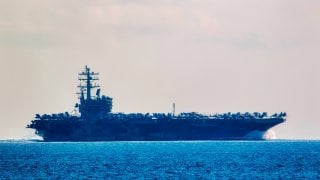U.S. Navy Aircraft Carriers Face A 'Ride or Die Moment'
With rising concerns over a potential Chinese invasion of Taiwan, U.S. military planners are reevaluating the role of aircraft carriers, traditionally key to power projection. Rapid Chinese advancements in anti-access/area-denial (A2/AD) technology mean carriers now face significant vulnerabilities in the Taiwan Strait.
What You Need to Know: With rising concerns over a potential Chinese invasion of Taiwan, U.S. military planners are reevaluating the role of aircraft carriers, traditionally key to power projection. Rapid Chinese advancements in anti-access/area-denial (A2/AD) technology mean carriers now face significant vulnerabilities in the Taiwan Strait.

-Emerging strategies propose withdrawing carriers to the second island chain while relying on autonomous drones or dispersed, mobile forces to blunt a Chinese assault and buy time.
-Carriers could serve as strategic reserves, forcing China to divert resources toward defense. This approach seeks a balance between utilizing carriers’ capabilities without risking their significant investment and symbolic value.
How Would U.S. Aircraft Carriers Defend Taiwan Amid Rising A2/AD Threats?
As the world progresses deeper into a decade of concern, military planners continue to contend with the potential of a Chinese invasion of Taiwan.
Chinese President Xi Jinping has made no secret of his ambitions toward the island nation. Should a military clash begin in the region, U.S. military leadership right now would be faced with several tough choices on how to respond. One of the key decisions would be how to use the U.S. Navy’s carriers. Once invulnerable floating fortresses, rapid Chinese advances in anti-access/area denial (A2/AD) capabilities leave these vessels facing new and serious risks. As thinking evolves, several theories on potential uses for carriers have begun to emerge.
Carrier Vulnerabilities and Traditional Roles
Naval strategy in the Pacific during the Second World War relied heavily on carriers. Though these vessels remained vulnerable to shore-based threats, across the vast reaches of America’s island-hopping campaign they were able to protect battle fleets and landing forces while projecting power against enemy fleets and positions.
Until the past decade or so, this is the role they would have filled in a conflict with China: sailing with impunity in the South and East China Seas, as well as the Strait of Taiwan, to rout Chinese landing forces and strike strategic locations on the mainland.

Major advances in both the quantity and quality of Chinese anti-ship missile systems have made this strategy untenable. Recent wargames projected the U.S. would lose two carriers at the outset of hostilities simply due to their presence within range of these systems. The saturation of the combat area with A2/AD systems means the Navy will be unlikely to employ carriers in their traditional role. It appears that establishment thinking has begun to understand this and to fight against the inertia of traditional plans to explore new strategies for defending Taiwan.
Outlining Different Strategies
It is widely recognized that allowing China unimpeded access to the Strait of Taiwan to conduct amphibious landings would result in Taiwanese defeat. While the Republic of China Armed Forces possess some capabilities to contest control of the Strait, it is likely these would be reduced to low operation capability shortly after the outbreak of hostilities, thanks to mainland China’s overwhelming quantitative superiority.
As discussed above, conventional U.S. forces are also at risk should they attempt to project power into the Strait. This is why some leaders are looking to lessons from Ukraine to make the Strait a “hellscape” for Chinese forces. In this scenario, the U.S. floods the region with autonomous aerial, surface, and subsurface drones: cheaply made, difficult to detect, and highly lethal.
The idea would be to limit the effectiveness of a Chinese landing and to buy Taiwanese and coalition defenders time to move assets into the region to blunt a Chinese assault.
A similar plan envisions drawing high-profile U.S. forces – such as carriers – back to or behind the second island chain. In their place would remain a dispersed, mobile force “to blunt Chinese attacks and reassure allied publics.”
These units would serve a similar function to the drones of the “hellscape” strategy, attacking valuable People’s Liberation Army Navy ships while incurring relatively few losses in return. While unable to fully stop an invasion, they could buy time for reserve forces to reach the battlefield.
How Do Aircraft Carriers Fit Into the Equation?
Whatever strategy the U.S. and allies pursue, the role of carriers will need to be re-evaluated. Some thought has already gone into the more granular aspects of strategy, but there is still much room for discussion and debate.
From a grand strategy perspective, carriers would be part of an outside force to assist mobile units in the first island chain. In this scenario, carriers would act almost as a reserve force to either plug any gaps on the defensive or exploit gaps on the offensive.

Simultaneously, holding carriers out of harm's way allows them to act as a “fleet in being” and require the PLA to devote resources to A2/AD instead of offensive capabilities aimed at taking Taiwan.
Finally, some envision upending the use case for carriers entirely and using them as a deceptive force to draw out Chinese resources without undertaking offensive missions essential to the war effort.
Much thought must be given to the use of carriers in a conflict with China. Continued advances in technology, such as the recently unveiled AIM-174B, will also change the calculus around carrier strategy, and planners must stay abreast of such developments.
While losses happen in war, carriers represent a massive investment. The loss of a carrier would be a devastating blow, not only strategically but also to the prestige of the U.S. As such, pursuing an appropriate strategy without succumbing to risk aversion is essential.
About the Author: Maya Carlin, Defense Expert
Maya Carlin, National Security Writer with The National Interest, is an analyst with the Center for Security Policy and a former Anna Sobol Levy Fellow at IDC Herzliya in Israel. She has by-lines in many publications, including The National Interest, Jerusalem Post, and Times of Israel. You can follow her on Twitter: @MayaCarlin.
All images are Creative Commons.


